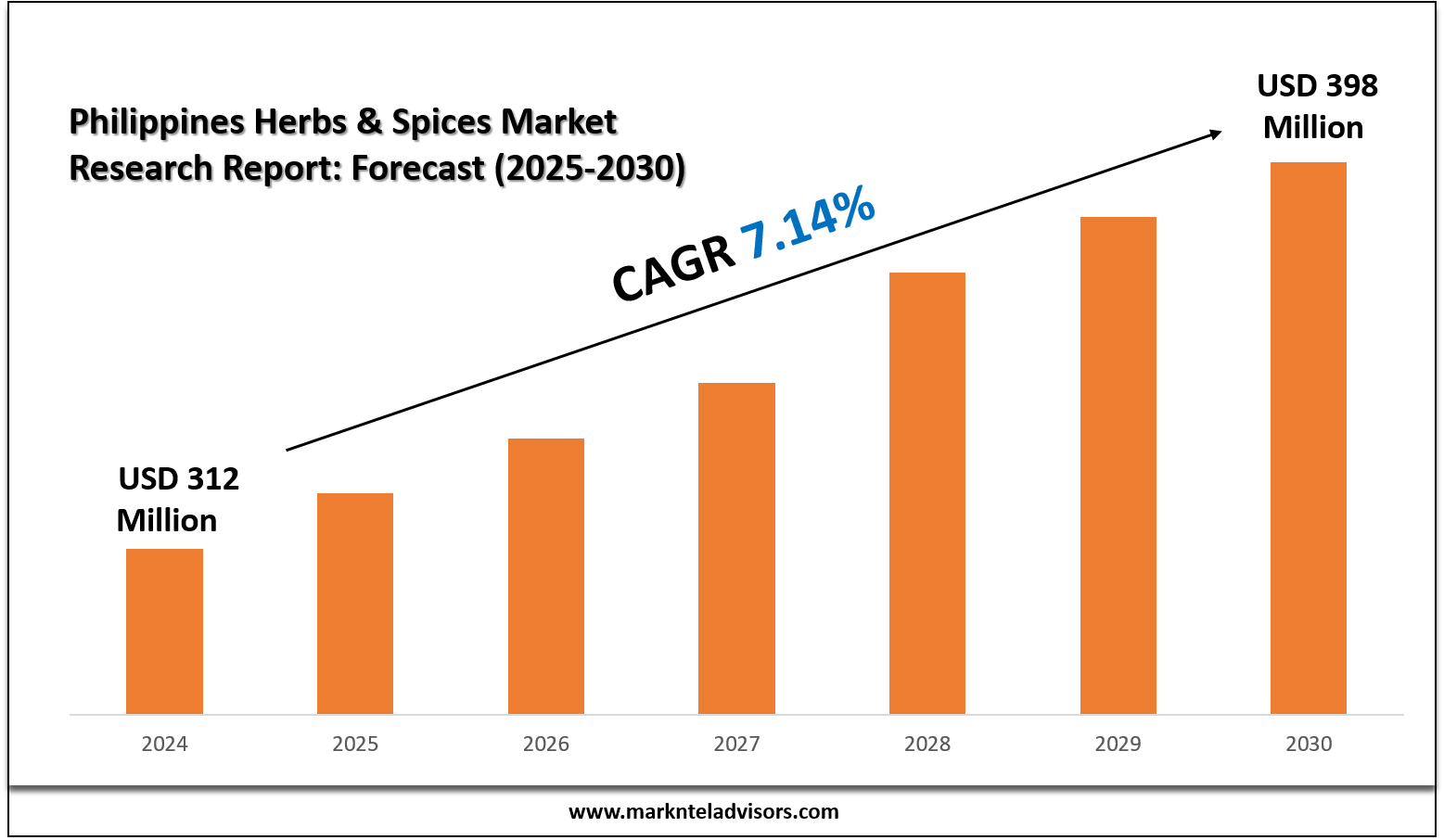Notifications

7 minutes, 24 seconds
-3 Views 0 Comments 0 Likes 0 Reviews

The Philippines Herbs & Spices Market size was valued at around USD312 million in 2024 and is expected to reach USD398 million by 2030. Along with this, the market is estimated to grow at a CAGR of around 7.14% during the forecast period, i.e., 2025-30. The Market growth is driven by the rising food services in the country, a sharp shift towards home-based cooking, the government support through significant investments, and the adoption of the latest farming practices, including precision agriculture. One of the major growth factors is the rising tourism in the country, due to which the country has uplifted its cultural cuisine spiced with Philippines flavors.
Herbs and spices are plant-derived substances used primarily for flavoring, coloring, or preserving food. They impart medicinal properties and distinctive aromas, contributing to culinary traditions across cultures. The classification of herbs and spices is based on the plant parts used: herbs are typically derived from leaves, while spices are sourced from seeds, fruits, roots, barks, or other plant parts.
Preview key insights – Download Report Free Sample Copy - https://www.marknteladvisors.com/query/request-sample/philippines-herbs-spices-market.html
The Philippines herbs and spices market can be segmented based on product type, distribution channel, and end-user.
By Product Type:
The spices segment holds a significant market share due to the rich culinary tradition in the Philippines, particularly utilizing native spices like siling labuyo (chili pepper) and ginger.
By Distribution Channel:
By End-User:
Households have shown rising demand due to increased interest in home cooking, further boosted by culinary trends promoted through social media.
The indigenous preferences for rich and diverse flavors drive the market demand. The resurgence of home cooking has been notable, especially after global pandemic conditions, which resulted in significant shifts towards home-prepared meals and explorations of culinary experiences at home.
Expansion of the Food Industry: The rapid growth within the food service sector and rising number of food establishments contribute to the increasing demand for herbs and spices. With about 40,000 metric tons of herbs and spices utilized in 2024, the expansion trend is imperative. The hospitality and tourism industry has also bolstered market growth, with about 5.4 million tourist arrivals in 2024, leading to heightened demand for local flavor profiles in food.
Government Support: The Philippine government has actively invested in agricultural initiatives to stimulate the production of herbs and spices. Locally focused agricultural programs and infrastructure development aimed at improving processing facilities indicate potential long-term benefits for farmers and market expansion.
Adoption of Precision Agriculture: Integrating advanced agricultural techniques has optimized productivity and sustainability in spice production. The use of AI and IoT solutions minimizes operational costs while maximizing crop yields, which will play a critical role in the future of the herbs and spices market.
Despite growth prospects, the market faces several challenges:
Unfavorable Weather Conditions: The Philippines is prone to natural calamities, including typhoons, which pose significant risks to agricultural output. Approximately 20 typhoons disrupt agricultural cycles yearly, affecting herbs and spices production.
Disease Management: Crop diseases caused by bacterial and fungal pathogens, such as basal rot and cercospora leaf spots, lead to substantial production losses. Effective disease management practices need to be prioritized for sustainable growth in the sector.
Key players in the Philippine herbs and spices market include McCormick Philippines Inc., GCHI, Fitrite Incorporated, and Leonie Agri Corp, among others. These companies are vying to enhance their product offerings to cater to changing consumer preferences and market demands.
The significant growth potential in the market can be attributed to:
E-commerce Growth: A shift towards online retail shopping presents opportunities for brands to reach wider audiences while leveraging digital marketing strategies.
Organic and Health-Conscious Options: Increasing consumer preference for organic and healthier options presents lucrative opportunities for businesses to innovate and cater specifically to this niche market.
Culinary Education and Awareness: As social media shapes culinary trends, educating consumers about the uses and benefits of various herbs and spices could further enhance market growth. Food bloggers and influencers can leverage this trend to promote traditional ingredients effectively.
The Philippines herbs and spices market is on a trajectory of continual growth, driven by evolving consumer behaviors, government support, and advancements in agricultural practices. Despite challenges posed by climatic conditions and crop diseases, businesses can tap into emerging opportunities presented by online retail channels and a shift towards organic products. With proper strategies and innovations, stakeholders can significantly influence the market dynamics in the coming years.
In conclusion, companies operating within this dynamic market must stay agile and responsive to changes in consumer preferences, regulatory environments, and technological advancements while securing their supply chains and enhancing their production capacities to capitalize on this growth phase.
Get in Touch Today:
Office No.109, H-159, Sector 63, Noida, Uttar Pradesh-201301, India
Contact No: +91 8719999009
Email: sales@marknteladvisors.com
Philippines Herbs & Spices Market Growth Philippines Herbs & Spices Market Share Philippines Herbs & Spices Market Size Philippines Herbs & Spices Market

